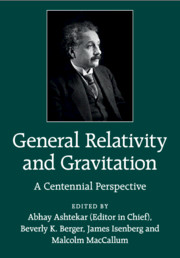Part Two - New Window on the Universe: Gravitational Waves
Published online by Cambridge University Press: 05 June 2015
Summary
Introduction
Gravitational waves provide an opportunity to observe the universe in a completely new way but also give rise to an enormous challenge to take advantage of this opportunity. When Einstein first found wave solutions in linearized general relativity and derived the quadrupole formula, it became clear that a laboratory experiment to produce and detect gravitational waves was impossible, while it was also clear that any gravitational wave signals produced astronomically were too weak to be detected on earth with the instruments available or thought possible at that time. Nearly 100 years later, we are at the confluence of fundamental science and technology that will soon open this new window.
Several lines of development were required to make the search for gravitational waves realistic. Despite the early recognition by Einstein that linearized gravity had wave solutions, the physical reality of gravitational waves remained in dispute for many decades. The reason for this was the absence of formalisms able to separate physical degrees of freedom in the field equations from coordinate (gauge) effects. A well known, striking example was Einstein's conviction that the Einstein–Rosen cylindrical waves [1] were not physical and furthermore that the character of this exact solution proved that there were no physical gravitational waves in the full theory. While Einstein retrieved the correct interpretation in the nick of time [2], the question remained unsettled until correct, gauge-invariant formulations of the problem were developed. The first of these, from Bondi's group [3-5], used the “news function” to demonstrate that, far from the source, one could quantify the energy carried away by gravitational waves. Further developments in understanding equations of motion, gauge freedom, and other methods to identify gravitational waves in the background spacetime led to approximation methods with greater precision and broader application than the original linear waves [6,7]. In addition, the first half-century of general relativity saw the physically relevant exact solutions of Schwarzschild [8] and, much later, Kerr [9].
- Type
- Chapter
- Information
- General Relativity and GravitationA Centennial Perspective, pp. 233 - 241Publisher: Cambridge University PressPrint publication year: 2015



